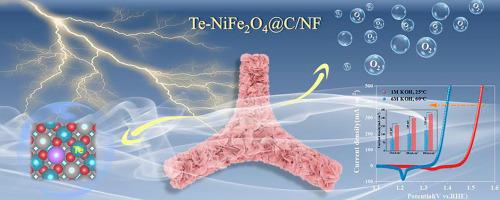Chemical Engineering Journal ( IF 13.3 ) Pub Date : 2023-03-25 , DOI: 10.1016/j.cej.2023.142604 Yanyan Li , Haoran Guo , Jiayang Zhao , Yao Zhang , Liyun Zhao , Rui Song

|
Constructing efficient oxygen evolution reaction (OER) electrocatalysts that can stably operate under high temperatures and strong alkaline conditions still faces great challenges for industrial hydrogen production from water electrolysis. Herein, a self-supported tellurium (Te)-doped spinel NiFe2O4 with a carbon-stabilized nanosheet structure anodic catalyst on nickel foam (NF) (Te-NiFe2O4@C/NF) is successfully synthesized by calcination of a layered double hydroxide precursor (NiFe LDH). Benefiting from Te doping as well as coupling with the amorphous carbon layer and the unique superhydrophilic/aerophobic surface property, which provides efficient mass transport channels and rapid electron transport, the optimized Te-NiFe2O4@C/NF requires an overpotential of 220 mV to achieve a current density of 10 mA cm−2 for the OER in 1 M KOH at 25 ℃. Furthermore, an extremely low overpotential of 180 mV is required to achieve 500 mA cm−2 in 6 M KOH at 80 ℃ and maintains superior stability over 60 h under such harsh quasi-industrial conditions. Density functional theory calculations further reveal that Te doping can effectively modulate the local electronic environment of the Ni and Fe sites, which optimizes the intermediate (*OH) adsorption and facilitates the OER kinetics. This work may open up opportunities to explore efficient electrocatalysts for scalable hydrogen production.
中文翻译:

Te 掺杂的 NiFe2O4 由无定形碳层稳定,该无定形碳层源自 NiFe LDH 的一步拓扑转变,具有显着增强的析氧反应
构建能够在高温和强碱性条件下稳定运行的高效析氧反应(OER)电催化剂对于电解水的工业制氢仍然面临着巨大挑战。在此,在泡沫镍(NF)(Te-NiFe 2 O 4 @C / NF)上通过煅烧成功合成了具有碳稳定纳米片结构阳极催化剂的自负载碲( Te )掺杂尖晶石NiFe 2 O 4层状双氢氧化物前体(NiFe LDH)。受益于 Te 掺杂以及与无定形碳层的耦合和独特的超亲水/疏水表面特性,提供有效的传质通道和快速电子传输,优化的 Te-NiFe2 O 4 @C/NF 需要 220 mV 的过电势才能在 25 ℃ 的 1 M KOH 中实现 10 mA cm -2的 OER 电流密度。此外,需要 180 mV 的极低过电势才能在 6 M KOH 中在 80 ℃ 下达到 500 mA cm -2并在如此恶劣的准工业条件下保持超过 60 小时的出色稳定性。密度泛函理论计算进一步表明,Te 掺杂可以有效调节 Ni 和 Fe 位点的局部电子环境,从而优化中间体 (*OH) 吸附并促进 OER 动力学。这项工作可能会为探索用于可扩展氢气生产的高效电催化剂提供机会。


















































 京公网安备 11010802027423号
京公网安备 11010802027423号